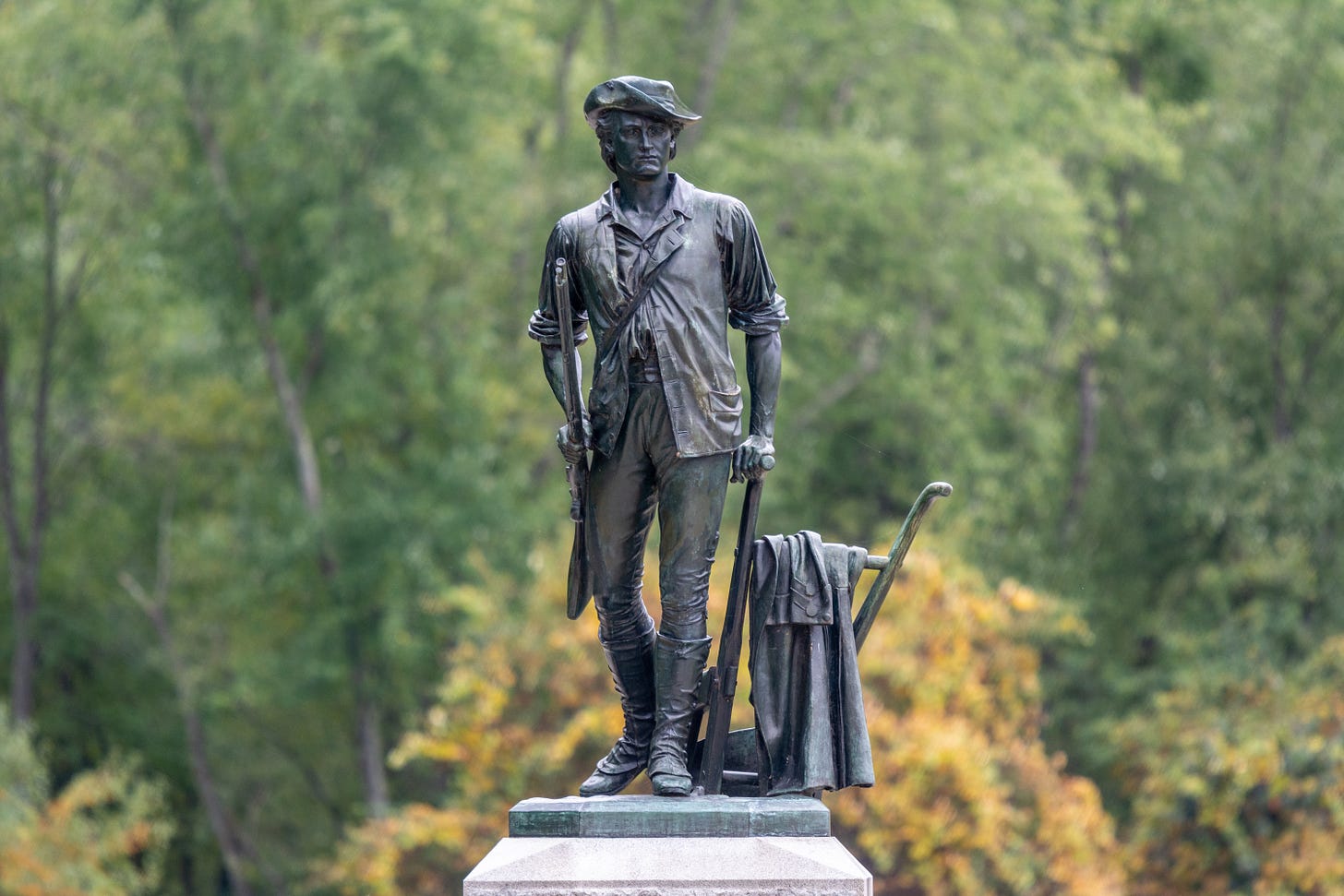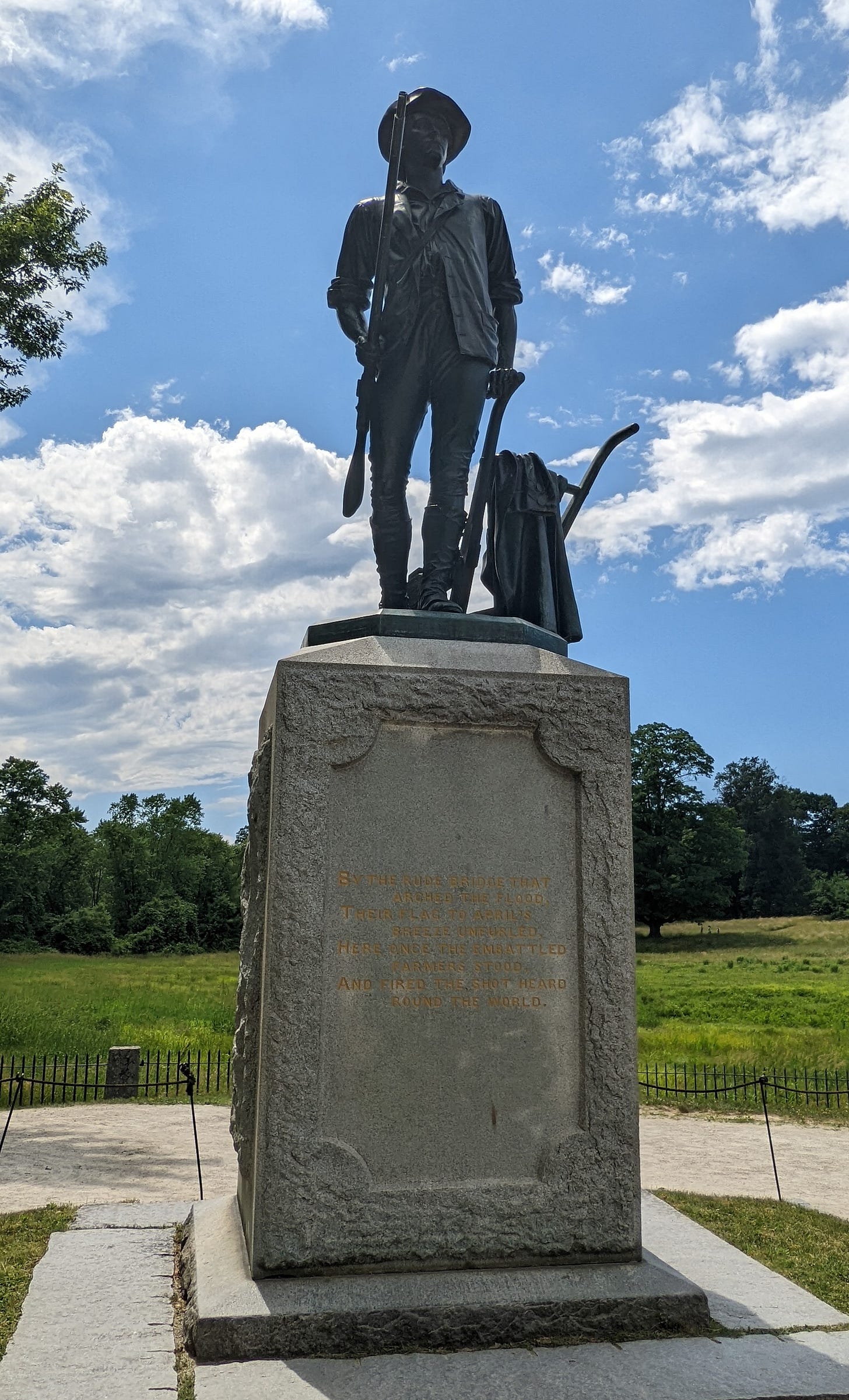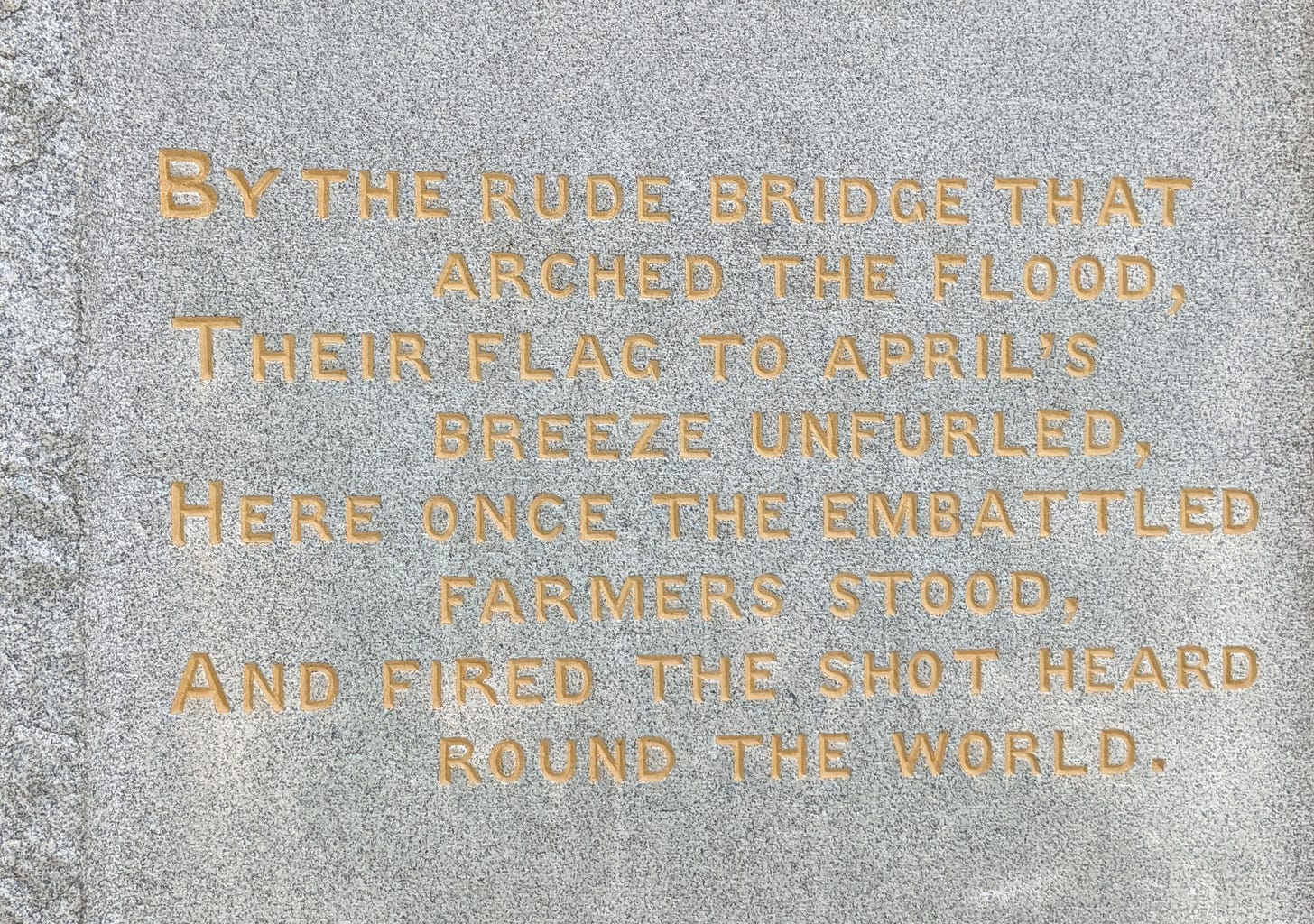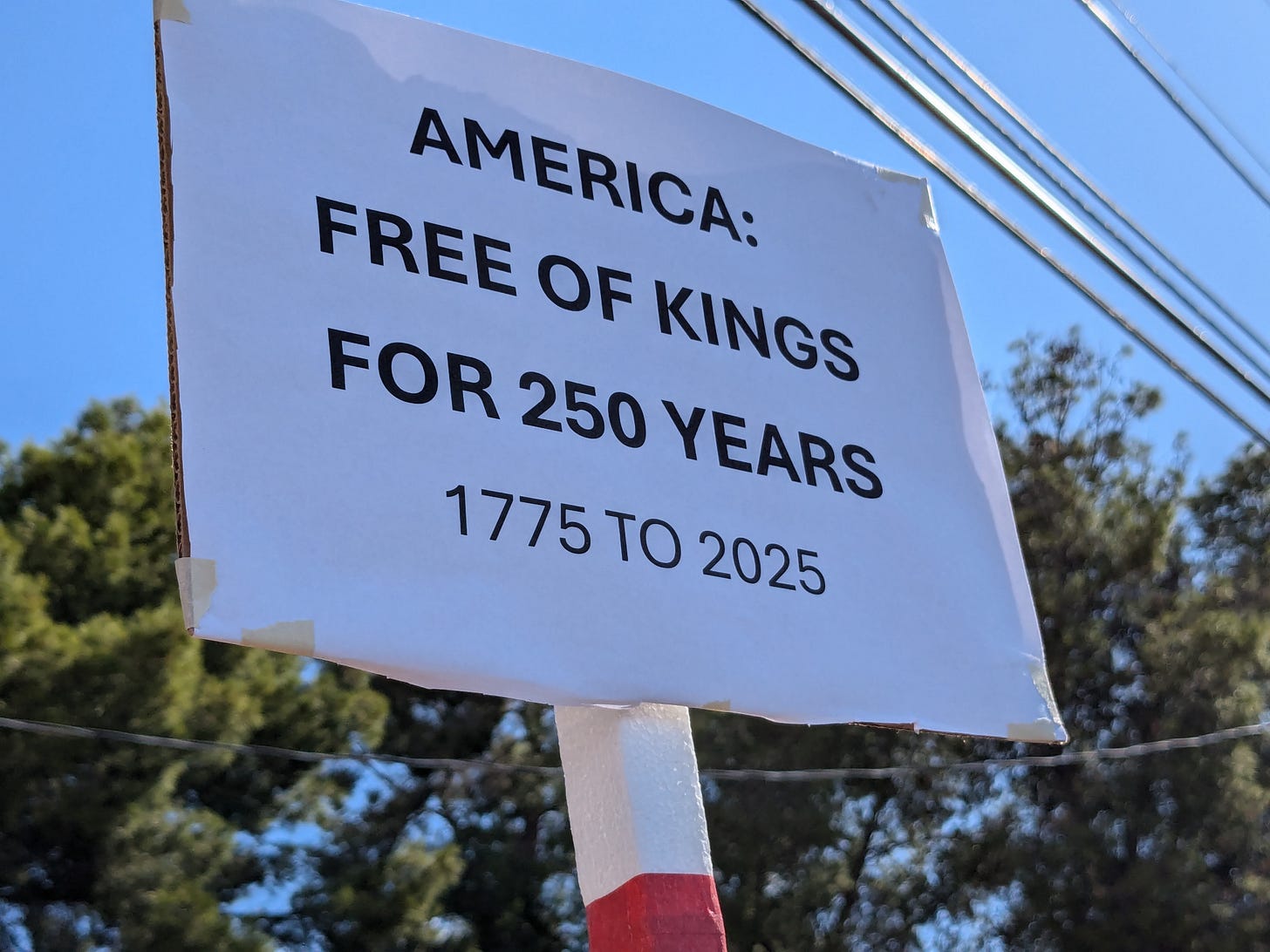Patriots' Day: 1775, 1849, and 2025
Thoughts on standing up to tyranny (and travel photos to ponder from Concord, Massachusetts).

Today was the official Patriots’ Day holiday in Massachusetts. The day when schools are closed, the Boston Marathon is run, and the Red Sox play an early game at Fenway Park so fans can walk to Kenmore Square afterwards and cheer on runners heading into the final mile of their 26.2-mile trek.
Of course, the reason the holiday exists is not for runners or baseball players, but rather as a way to commemorate the first battle of the Revolutionary War at Lexington and Concord on April 19, 1775. This past Saturday happened to be the actual 250th anniversary of that battle (the holiday is always on a Monday) and it was marked by several million Americans who protested in every state against the creeping authoritarianism of the current administration.
So between the anniversary and the protests, it seems like a perfect time to ponder some photos that represent Patriots’ Day 1775 and 2025, with a bonus look at something else that happened to take place in Concord — in 1849 — which is linked to the same tradition of standing up to government.
1775
On the evening of April 18, 1775, amidst rising tensions between Britain and her American colonies, some 700 British troops set out from Boston intending to seize a cache of weapons stored in Concord. American spies who learned of the plan devised the “one if by land, two if by sea” lantern signal in the Old North Church to inform local patriots of the troops’ route. This is what spurred Paul Revere’s ride, when he and others set off on horseback to race through the night and alert nearby towns of the impending arrival of British troops.
When the British made it to Lexington early the next morning, they were surprised to find 70 militia men waiting for them. Someone (whose identity is unknown) fired a shot, and in the volley that followed, seven Americans were killed. The British then marched on to Concord, where 400 local militia had gathered by the North Bridge over the Concord River. When the British opened fire this time, the militia fought back and killed three British soldiers, forcing the king’s troops to retreat.
It was this battle that was commemorated as the “shot heard ‘round the world.” It marked the start of the revolution that made the United States a country. Six decades later, when a monument to the battle was erected by Concord’s North Bridge, Ralph Waldo Emerson composed a poem for the occasion, which is carved at the base of the statue.
By the rude bridge that arched the flood,
Their flag to April’s breeze unfurled,
Here once the embattled farmers stood
And fired the shot heard round the world.
As the British troops returned to Boston, they were attacked at various points along the way by what were now thousands of colonists who had arrived throughout the day and waited in ambush along what came to be known as Battle Road. By the time they made it back to Boston, 73 British troops and 49 Americans were dead.
The patriots of Boston, Concord, Lexington, and other surrounding towns that day believed they were standing up for their rights against what they perceived as the tyrannical rule of King George III. This battle set off a series of events that ended, almost 15 months later, with the Americans’ Declaration of Independence.
1849
This second event did not take place on April 19, but it did also happen in Concord and it’s closely linked to the philosophy of citizens standing up for their beliefs in opposition to what they see as an unjust government.
As I’ve written about, Concord in the mid-19th century was home to a remarkable collection of literary talent. Ralph Waldo Emerson, Henry David Thoreau, Nathaniel Hawthorne, and Louisa May Alcott all lived there at the same time. And a display at Minute Man National Historical Park notes that these authors not only sparked an American literary revolution but were also committed to certain political ideals, from opposing slavery to promoting independence of thought.
Thoreau, in fact, once spent a night in jail for refusing to pay a poll tax as his way of protesting slavery and America’s role in the Mexican War.
It was also Thoreau who in 1849 published an essay entitled Resistance to Civil Government. Seventeen years later, it was reprinted with a new title of Civil Disobedience, which is how it is still known today.
Why is this important?
In Civil Disobedience, Thoreau laid out a rationale for why citizens have a duty to follow their conscience in resisting the actions of an unjust government.
He also wrote:
"The progress from an absolute to a limited monarchy, from a limited monarchy to a democracy, is a progress toward a true respect for the individual … There will never be a really free and enlightened State until the State comes to recognize the individual as a higher and independent power, from which all its own power and authority are derived, and treats him accordingly.”
More than a half-century later, Thoreau’s work was one of the inspirations behind the philosophy of nonviolent protest developed by Mahatma Gandhi, which he used when leading India to break free from British rule. Gandhi’s philosophy in turn inspired Martin Luther King, Jr.’s leadership of the civil rights movement in America in the 1950s and 1960s.
So the words Thoreau wrote in Concord in the mid-19th century reverberated for generations into the future and helped inspire some of history’s most successful nonviolent protest movements.
2025
You can see the throughline, then, from the “embattled farmers” who stood up to the British empire in 1775 to the writings of Thoreau in 1849 to the movements led by Gandhi and King. The first ignited a revolutionary war while the others were nonviolent movements, but they’re united by a desire to oppose unjust government.
And the link persists even today, with the protests that have broken out across America this past month against a government that seems bent on destroying not only independent media and higher education but also a system of checks and balances that has enabled U.S. democracy to stand strong since the 1700s.
Speaking of which, the campus of Harvard University is 15 miles from Concord’s North Bridge and four miles or so from the Old North Church and from Paul Revere’s House. So perhaps it was appropriate that Harvard was the first major institution to fight back against the Trump administration after other universities and major law firms initially caved to the pressure. Now, some of these institutions are lining up in support of Harvard’s fight. Courage, as they say, is contagious.
As far as I can tell, estimates are that about 5 million people in 1,300 locations took part in the April 5th “Hands Off” protests, and 3 million people in 700 or so locations were part of the April 19 “No Kings” protest. Comparatively, around 500,000 people in 700+ locales participated in the biggest day of Tea Party protests on April 15, 2009.
So this is not a small movement. It shows that many Americans are willing to stand up for the preservation of democracy against the threat of authoritarianism, and for the just state that Thoreau wrote about 176 years ago. No one knows where this is going, but it shows at least that the spirit of Patriots’ Day is still strong.
Photos: Cover photo via Shutterstock. All other photos by Bob Riel.








